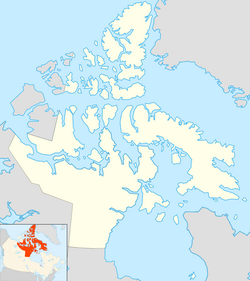Angikuni Lake
| Angikuni Lake | |
|---|---|

Angikuni Lake, July 2014
|
|
| Location | Kivalliq Region, Nunavut |
| Coordinates | 62°12′N 99°59′W / 62.200°N 99.983°WCoordinates: 62°12′N 99°59′W / 62.200°N 99.983°W |
| Primary inflows | Kazan River |
| Primary outflows | Kazan River |
| Basin countries | Canada |
| Surface area | 510 km2 (197 sq mi) |
| Surface elevation | 257 m (843 ft) |
| Islands | Many |
| Settlements | uninhabited |
Angikuni Lake (variant: Lake Anjikuni) is a lake in Kivalliq Region, Nunavut, Canada. It is one of several lakes located along the Kazan River; Ennadai Lake is to the south and Yathkyed Lake is to the north.
The lake's shore is notable for rocky outcroppings of the Precambrian Shield, being part of the Hearne Domain, Western Churchill province of the Churchill Craton.
Barren-ground Caribou migrate through the area. The lake contains Lake trout, Northern pike, and Arctic grayling.
During his 1948 trip, Canadian explorer Farley Mowat arrived at Angikuni Lake, then part of the Northwest Territories, and found a cairn constructed in a fashion not normally used by area Inuit. It contained pieces of a hardwood flattened box with dovetailed corners. Mowat, knowing that only one other European explorer, Samuel Hearne, had been in this region previously (in 1770), speculated that the monument was built by Francis Crozier, who, as a member of the lost expedition originally led by Sir John Franklin, vanished in 1848 during the ill-fated search for the Northwest Passage. (Woodman, 1991, p. 317)
In 1930, a newsman in The Pas, Manitoba, reported on a small Inuit village right off of Lake Angikuni. The village had always welcomed the fur trappers who passed through occasionally. But in 1930 Joe Labelle, a fur trapper well known in the village, found that all the villagers had gone. He found unfinished shirts that still had needles in them and food hanging over fire pits and therefore concluded that the villagers had left suddenly. Even more disturbing, he found seven sled dogs dead from starvation and a grave that had been dug up. Labelle knew that an animal could not have been responsible because the stones circling the grave were undisturbed. He reported this to the Royal Canadian Mounted Police (Kelleher refers to them using the anachronism North-West Mounted Police), who conducted a search for the missing people; no one was ever found.
...
Wikipedia

